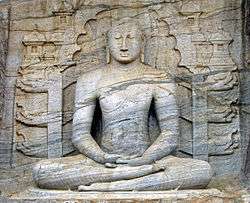Ratana Sutta
| Part of a series on |
| Theravāda Buddhism |
|---|
 |
The Ratana Sutta (Burmese: ရတနသုတ်) is a Buddhist discourse (Sanskrit sutra Pali, sutta) found in the Pali Canon's Sutta Nipata (Snp 2.1) and Khuddakapatha (Khp 7); with a parallel in the Mahavastu. In the Pali it is seventeen verses in length, and in the Sanskrit version nineteen.[1] The Ratana Sutta extols the characteristics of the three ratana (Pali for "gem" or "jewel" or "treasure") in Buddhism: the Enlightened One (Buddha), the Teaching (Dhamma) and the noble community of disciples (ariya Sangha).
Background
In Theravada Buddhism, according to post-canonical Pali commentaries, the background story for the Ratana Sutta is that the town of Vesali (or Visala) was being plagued by disease, non-human beings and famine; in despair, the townspeople called upon the Buddha for aid; he had the Ven. Ananda go through town reciting this discourse leading to the dispersal of the town's woes.[2]
Contents
The Ratana Sutta upholds the Three Jewels as follows:
- the Buddha as the unequalled Realized One (verse 3: na no samam atthi Tathagatena)
- the Teaching (dhamma) of:
- the noble Community (ariya sangha) for having:
- attained Nirvana (verses 7: te pattipatta amatam vigayha),
- realized the Four Noble Truths (verses 8-9: yo ariyasaccani avecca passati), and
- abandoned the first three fetters (verse 10: tayas su dhamma jahita bhavanti) that bind us to samsara.[3]
Use
In Theravada countries and institutions, this discourse is often recited as part of religious, public and private ceremonies for the purpose of blessing new endeavors and dispelling inauspicious forces.[4]
See also
- Paritta - traditional Buddhist "protective suttas," including the Ratana Sutta.
- Three Jewels
Notes
- ↑ See Anandajoti Ratanasutta - A Comparative Edition
- ↑ See, e.g., Anandajoti (2004), p. 45, "Introductory Verses" to the Ratana Sutta; and, Bodhi (2004).
- ↑ For a transcription of the Pali along with a line-by-line English translation, see, e.g., Anandajoti (2004), pp. 45-52.
- ↑ See, e.g., Piyadassi (1999); and, Bodhi (2004).
Sources
- Anandajoti Bhikkhu (ed., trans.) (2004). Safeguard Recitals. Kandy: Buddhist Publication Society. ISBN 955-24-0255-7.
- Bodhi, Bhikkhu (2004). "Sn 2.1 Ratana Sutta — Jewels [part 1]" (lecture). Retrieved from "Bodhi Monastery" at http://www.bodhimonastery.net/courses/Sn/MP3/Sn001_Ratana.mp3 (mp3).
- Piyadassi Thera (ed., trans.) (1999). The Book of Protection: Paritta. Kandy: Buddhist Publication Society. Retrieved 08-14-2008 from "Access to Insight" at http://www.accesstoinsight.org/lib/authors/piyadassi/protection.html.
External links
- Piyadassi Thera (trans.) (1999). Ratana Sutta: The Jewel Discourse (Sn 2.1). Retrieved 08-22-2008 from "Access to Insight" at http://www.accesstoinsight.org/tipitaka/kn/snp/snp.2.01.piya.html.
- Thanissaro Bhikkhu (trans.) (1994). Ratana Sutta: Treasures (Sn 2.1). Retrieved 08-22-2008 from "Access to Insight" at http://www.accesstoinsight.org/tipitaka/kn/snp/snp.2.01.than.html.
- Anandajoti Bhikkhu (trans.) (2004). The Discourse on the Treasures. Part of Safeguard Recitals (300+ pages)
- Chandrabodhi chants the Ratana Sutta and other suttas in an 'Indian style' at freebuddhistaudio